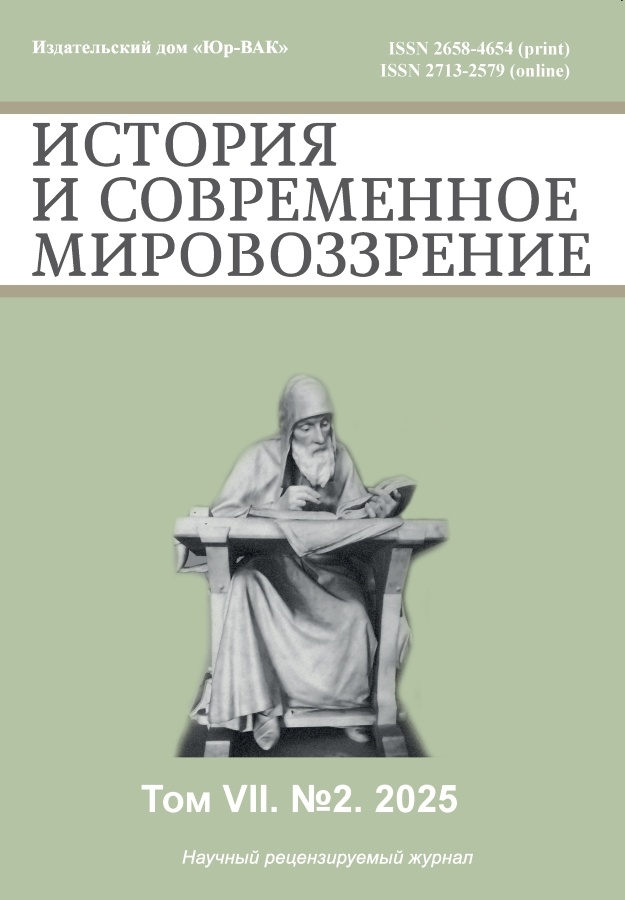Activities of the Supreme Commander-in-Chief's Headquarters for the Interaction of the Armed Forces of the Russian Empire during the Warsaw-Ivangorod Operation
- Autores: Panteleev P.V.1
-
Afiliações:
- Military Academy of the General Staff of the Armed Forces of the Russian Federation (Research Institute (VI) VAGSH of the Armed Forces of the Russian Federation)
- Edição: Volume 7, Nº 2 (2025)
- Páginas: 21-28
- Seção: HISTORY OF RUSSIA
- URL: https://journals.eco-vector.com/2658-4654/article/view/688803
- DOI: https://doi.org/10.33693/2658-4654-2025-7-2-21-28
- EDN: https://elibrary.ru/HRTXUS
- ID: 688803
Citar
Texto integral
Resumo
Relevance. The activities of the Supreme Commander's Headquarters for the interaction of troops during the Warsaw-Ivangorod operation are its most important component. Knowledge of the structure, content and procedure of maintaining interaction during the operation will allow us to study the historical experience of his leadership and the possibilities of using the acquired knowledge in modern conditions. The purpose of the article is to familiarize with the activities of the Supreme Commander-in-Chief's Headquarters (VGK) in directing the interaction of troops during the Warsaw-Ivangorod operation, as well as a private offensive operation in East Prussia in the Augustow area conducted by the troops of the Northwestern Front and to cover the enemy from the southwestern direction from the Carpathians. Methodology. The use of basic modern research methods such as historical-systemic, historical-typological and synthesis of information from published sources and archival documents allowed us to study a fairly large number of historical documents of the Headquarters of the Supreme Commander, the North-Western and South-Western fronts in the First World War. Results. The study reveals the sequence and content of the activities of the Headquarters of the Supreme Commander-in-Chief (VGK), the field directorates of the fronts for directing the interaction of troops during the Warsaw-Ivangorod operation. Conclusions. Based on the reviewed historical and analytical documents. The structure of the activities of the Supreme Commander-in-Chief's Headquarters (VGK) for directing the interaction of troops during the Warsaw-Ivangorod operation is revealed. Conclusions are drawn about the methods of maintaining the interaction of troops and the sequence of achieving sustainable interaction during the operation.
Texto integral
Sobre autores
Peter Panteleev
Military Academy of the General Staff of the Armed Forces of the Russian Federation (Research Institute (VI) VAGSH of the Armed Forces of the Russian Federation)
Autor responsável pela correspondência
Email: panteleew.p@yandex.ru
Código SPIN: 9046-8847
Cand. Sci. (Military), Senior Researcher at the Scientific Research Institute (Military History)
Rússia, MoscowBibliografia
- Viziltir E.V. Formation of a Negative Worldview towards the Autocratic Power among the Population of the Russian Empire in 1916 // Bulletin of the South-West State University. Series: History and Law. 2025. Vol. 15, No. 1. 207–215.
- Gavrilov A.G., Pryamitsyn V.N. Establishment of Multi-Aspect and Multi-Level Typification Using the Example of a Study of the History of Meteorological Support for the Red Army Air Forces during the Great Patriotic War (1941–1945). // Bulletin of the South-West State University. Series: History and Law. 2022. Vol. 12, No. 5.
- Golovin N.N. Russia's Military Efforts in the World War. Moscow: Kuchkovo Pole. 2001. P. 301.
- Oleynikov A.V. Russian military art of the First World War. Moscow: Yauza. 2019. P. 19.
Arquivos suplementares












